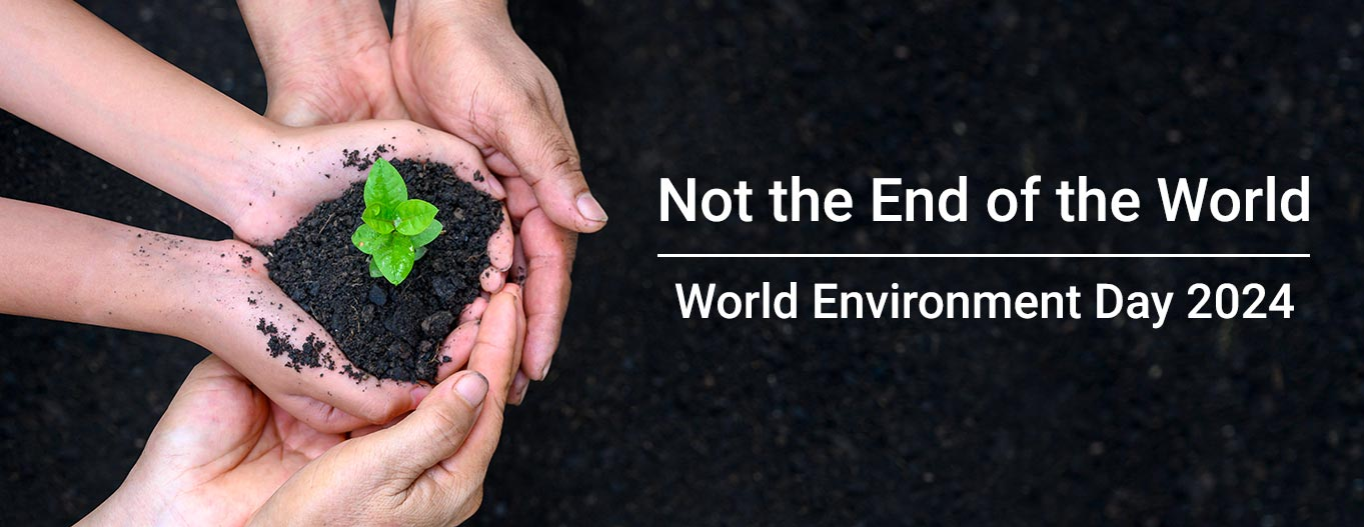
This article is a part of the essay series: Not the End of the World: World Environment Day 2024
With global temperatures rising steadily, and human populations expanding relentlessly, large swathes of the planet are becoming vulnerable to desertification or the “permanent degradation of land that was once arable”. According to National Geographic, over 2 billion people live on drylands prone to desertification, and the progressive degradation of these lands could displace 50 million people by 2030.
The growing pace of degradation has begun to alarm experts. Recent data released by the UN Convention to Combat Desertification (UNCCD) indicates that during the period 2015–19, around 402 million hectares of land were degraded, averaging 100 million hectares a year, and impacting 1.3 billion people. The stakes are high. Unless 1.5 billion hectares of land are restored by 2030 it may not be possible to achieve a land-degradation-neutral world, feels the UNCCD.
Artificial Intelligence (AI) is proving to be a valuable ally in the fight against desertification. As we observe World Environment Day 2024 on the theme ‘Land Restoration, Desertification, and Drought Resilience’, it is worth taking a closer look at the role AI is playing, and the challenges we must address as we develop new AI-based solutions.
Some transformative AI solutions
AI is being used in a variety of ways to support efforts to combat desertification. In August 2023, for instance, the arid Kingdom of Saudi Arabia launched a large-scale counter-desertification programme under which AI algorithms are analysing satellite images to monitor changes in land use, vegetation cover, and soil moisture levels. The deployment of AI is helping detect and assess desertification trends in vulnerable areas, and supporting decisions about actions to be taken such as improving water management, planting trees and shrubs, and promoting sustainable agriculture.
Drones equipped with AI-powered sensors help capture high-resolution data from remote or inaccessible regions, providing insights into soil and vegetation conditions, and allowing us to devise tailored mitigation strategies. In the United Kingdom (UK), the United States (US), and Australia, AI-guided drones are being used to plant trees in degraded areas or to enable reforestation projects—in what has come to be called “aerial drone seeding”—ensuring optimal planting patterns, and tracking tree growth over time.
Drones equipped with AI-powered sensors help capture high-resolution data from remote or inaccessible regions, providing insights into soil and vegetation conditions, and allowing us to devise tailored mitigation strategies.
Predictive modelling is yet another area where AI has found widespread use. AI models predict future climate patterns and extreme weather events that could contribute to desertification. They also predict which areas are potentially at high risk of degradation by analysing historical data, land use patterns, and environmental factors. Microsoft’s “AI for Earth” initiative, for example, encourages a broad spectrum of AI use cases to accelerate the preservation of the environment, including efforts to fight desertification. In southeast Spain, stakeholders are participating in “AI for Earth” by integrating machine learning tools with geospatial data analytics and machine vision techniques to build predictive models of the demand and contributions of water in local agricultural regions.
Challenges to AI deployment
While AI holds out much promise for combating desertification, several factors could hinder its deployment. Desertification often affects relatively remote or underdeveloped regions where data collection practices are rudimentary, and data is sparse or simply does not exist. To some extent, this may be seen as part of the broader data divide between countries of the Global South and those of the North, where some of the former “lack access to even basic digital infrastructure, making it difficult to capture data that might benefit them”. The paucity of data – including, in this case, datasets of aerial images – and the difficulty of crafting AI solutions are also often linked to skill gaps. Quite simply, AI-related technical expertise is likely to be lacking in the regions most severely affected by desertification.
Securing funding and investment for long-term AI projects can be difficult; and the high costs associated with developing and deploying AI solutions could act as a major hurdle in economically disadvantaged areas. Moreover, environmental variability could itself sometimes become a stumbling block. Desertification is influenced by a complex interplay of factors that can on occasion be difficult to model accurately with AI. Climatic instability can alter conditions unpredictably, complicating AI predictions and interventions.
Securing funding and investment for long-term AI projects can be difficult; and the high costs associated with developing and deploying AI solutions could act as a major hurdle in economically disadvantaged areas.
Finally, navigating the regulatory landscape to implement AI technologies can be tough, especially in countries with stringent approaches to AI governance. The management and governance of environmental data present their own challenges. As studies of environmental data value chains in Europe and Central Asia have shown, shared environmental information systems expand access to relevant data, but data harmonization—in terms of collection methods, the nature and categories of data, and the legislation that allows data sharing—continue to be a persistent problem.
Towards a green and resilient planet
The fight against desertification is at a critical juncture and 2030 could signal a tipping point, but the potential of AI offers hope. AI is shaping our ability to understand, predict, and mitigate the impacts of desertification with unprecedented precision and efficiency. Whether in North America or China, Ghana or Israel, AI-powered tools and analysis are helping us monitor land degradation in real time, execute targeted reforestation projects, and craft sustainable land management practices.
Despite the challenges—from data scarcity and insufficient capacities to funding constraints and regulatory hurdles—AI's role in fighting desertification is poised to grow. A particular push is needed to make larger volumes of relevant environmental data available. Open, public datasets like the Aerial Image Dataset (AID), which bring together diverse images from different countries and regions, are an asset for AI developers; and more datasets of this kind ought to be built collaboratively. Moreover, while cross-border data-sharing continues to be a thorny issue, there have been calls within groups like the G20 to facilitate the sharing of certain classes of development data which have implications for regional policymaking, or for evolving tech-based solutions to transnational challenges. Desertification is precisely such a challenge, and a corpus of relevant multi-country environmental data could be very useful.
Despite the challenges—from data scarcity and insufficient capacities to funding constraints and regulatory hurdles—AI's role in fighting desertification is poised to grow.
The celebration of World Environment Day is, thus, among other things, an occasion to remind ourselves of the transformative power of AI to help restore vital natural ecosystems. And it is a moment for us to reflect on how technology might best be harnessed to build a greener and more resilient planet.
Anirban Sarma is a Deputy Director and Senior Fellow at the Observer Research Foundation.
The views expressed above belong to the author(s). ORF research and analyses now available on Telegram! Click here to access our curated content — blogs, longforms and interviews.




 PREV
PREV

.png)
.png)
